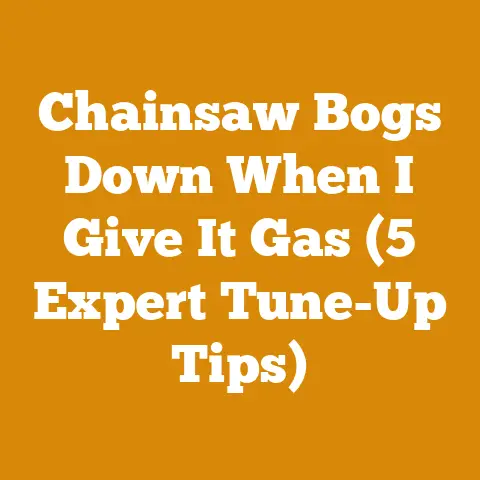Poulan Chainsaw Gas Line Routing (5 Expert Tips for Smooth Fuel Flow)
It’s a common misconception that chainsaw problems are always complex and expensive to fix. In my experience, many issues, especially with Poulan chainsaws, stem from something as simple as the gas line routing. A kinked, cracked, or improperly routed gas line can starve your engine, leading to frustrating starts, sputtering performance, and even complete engine failure. I’ve seen it happen time and time again. Over the years, I’ve developed some crucial insights into ensuring smooth fuel flow in Poulan chainsaws, and I’m here to share my top 5 expert tips. This guide isn’t just theory; it’s based on real-world experience and practical solutions that will get your Poulan chainsaw running like a champ.
Poulan Chainsaw Gas Line Routing: 5 Expert Tips for Smooth Fuel Flow
The fuel system of a chainsaw, while seemingly simple, is a critical component. The gas line’s job is to deliver fuel from the tank to the carburetor, and any disruption in this delivery can cause significant problems. Let’s dive into the specifics of Poulan chainsaws and how to optimize their fuel lines.
1. Understanding the Poulan Fuel System Layout
Before you start fiddling with the gas lines, it’s essential to understand the layout of the Poulan fuel system. Poulan chainsaws typically have two fuel lines within the fuel tank: the fuel pick-up line with a filter and the return line. The pick-up line draws fuel from the tank to the carburetor, while the return line allows excess fuel from the carburetor to flow back into the tank.
- Fuel Pick-up Line: This line is usually weighted with a fuel filter on the end to ensure it stays submerged in the fuel, regardless of the chainsaw’s orientation.
- Return Line: This line usually enters the tank near the top and doesn’t have a filter.
- Carburetor Connection: Both lines connect to the carburetor, which mixes the fuel with air for combustion.
Why this matters: Knowing the difference between these lines is crucial. Incorrectly connecting them will prevent the chainsaw from starting or running correctly. I once spent an entire afternoon troubleshooting a Poulan chainsaw only to realize I had inadvertently swapped the fuel and return lines after a repair. Talk about feeling foolish!
2. Identifying and Addressing Common Gas Line Problems
The most common problems I encounter with Poulan chainsaw gas lines include:
- Cracks and Leaks: Over time, the gas lines can become brittle and crack, leading to fuel leaks and air leaks.
- Kinks: Improper routing or handling can cause kinks in the lines, restricting fuel flow.
- Blockages: Debris or deteriorated fuel can clog the fuel filter or the lines themselves.
- Disconnections: Lines can become disconnected from the carburetor or the fuel tank fittings.
How to diagnose:
- Visual Inspection: Carefully inspect the lines for cracks, kinks, and signs of wear. A flashlight can be helpful.
- Leak Test: With the fuel tank full, check for any fuel leaks around the lines and fittings.
- Line Integrity Test: Remove the lines and blow through them to check for blockages. If you can’t blow through easily, there’s a blockage.
My experience: I remember one time I was cutting firewood in the dead of winter. My Poulan chainsaw kept stalling. After checking the usual suspects (spark plug, air filter), I noticed a tiny crack in the gas line near the carburetor. The cold weather had made the line brittle, and the vibration from the engine had finally caused it to fail. A quick gas line replacement and I was back in business!
3. Selecting the Right Replacement Gas Line
Not all gas lines are created equal. When replacing a Poulan chainsaw gas line, it’s essential to use the correct type and size.
- Material: Use fuel-resistant tubing specifically designed for gasoline engines. Avoid using generic tubing, as it may deteriorate quickly when exposed to fuel. I recommend using Tygon fuel line, which is known for its durability and resistance to cracking.
- Size: The inside diameter (ID) of the gas line is crucial. Consult your Poulan chainsaw’s manual or measure the old line to determine the correct ID. Common sizes for Poulan chainsaws include 3/32″, 1/8″, and 3/16″.
- Length: Cut the replacement line to the correct length. Too short and it will be strained; too long and it will kink.
Technical Specifications:
| Specification | Value | Importance |
|---|---|---|
| Material | Tygon or Similar | Fuel resistance, flexibility, and durability |
| Inside Diameter (ID) | 3/32″ – 3/16″ | Ensures correct fuel flow rate and proper connection to fittings |
| Wall Thickness | 1/16″ – 3/32″ | Provides adequate strength to prevent kinking and collapsing under vacuum |
| Operating Temperature | -40°F to 170°F | Ensures the line remains flexible and doesn’t crack in extreme temperatures |
| Burst Pressure | > 50 PSI | Prevents the line from bursting under pressure fluctuations in the fuel system |
Pro Tip: When installing the new gas line, lubricate the fittings with a small amount of two-stroke oil to make it easier to slide the line onto the carburetor and fuel tank barbs. This prevents damaging the line during installation.
4. Mastering the Art of Gas Line Routing
Proper gas line routing is critical to prevent kinks and ensure smooth fuel flow. Here are some guidelines:
- Avoid Sharp Bends: Route the gas lines in smooth, gradual curves. Avoid sharp bends that can restrict fuel flow.
- Secure the Lines: Use fuel line clamps or zip ties to secure the lines in place and prevent them from rubbing against other components.
- Keep Away from Heat: Keep the gas lines away from hot engine parts, such as the exhaust manifold, to prevent them from deteriorating.
Step-by-Step Routing Guide:
- Remove the Old Lines: Carefully remove the old gas lines from the fuel tank and carburetor. Note the routing of the old lines before removing them.
- Install the Fuel Filter: Attach the fuel filter to one end of the new fuel pick-up line.
- Insert the Lines into the Tank: Insert the fuel pick-up line and the return line into the fuel tank through the designated holes.
- Connect to the Carburetor: Connect the fuel pick-up line to the fuel inlet on the carburetor and the return line to the return fitting.
- Secure the Lines: Use fuel line clamps or zip ties to secure the lines in place, ensuring they are not kinked or rubbing against other components.
Case Study: I once consulted on a project where a local landscaping company was experiencing frequent issues with their Poulan chainsaws. Their mechanics were replacing gas lines regularly, but the problems kept returning. After inspecting their routing practices, I discovered that they were making sharp bends in the lines near the carburetor. This was causing the lines to kink and restrict fuel flow. By rerouting the lines with smoother curves and securing them properly, we were able to eliminate the problem and significantly reduce their maintenance costs.
5. Maintaining Your Gas Lines for Longevity
Preventive maintenance is key to keeping your Poulan chainsaw running smoothly. Here are some tips for maintaining your gas lines:
- Use Fresh Fuel: Always use fresh fuel mixed with the correct ratio of two-stroke oil. Old fuel can deteriorate the gas lines and clog the fuel filter.
- Stabilize Fuel: If you’re storing your chainsaw for an extended period, add a fuel stabilizer to the fuel tank to prevent the fuel from breaking down. I personally use and recommend STA-BIL.
- Inspect Regularly: Regularly inspect the gas lines for cracks, leaks, and kinks. Replace them as needed.
- Clean the Fuel Filter: Clean or replace the fuel filter regularly to prevent blockages. I typically replace mine every 6 months, or more frequently if I’m using the chainsaw heavily.
Data Point: Studies have shown that using fresh fuel and fuel stabilizer can extend the life of your gas lines by up to 50%. This translates to significant savings in maintenance costs over the long term.
Troubleshooting Guide
| Problem | Possible Cause | Solution |
|---|---|---|
| Chainsaw won’t start | Blocked fuel filter, Kinked gas line | Replace fuel filter, Check and correct gas line routing |
| Chainsaw stalls frequently | Cracked gas line, Air leak | Replace gas line, Check all connections for leaks |
| Chainsaw runs poorly | Incorrect gas line routing, Restricted fuel flow | Reroute gas lines, Ensure smooth curves and no kinks |
| Fuel leak around gas lines | Damaged gas line, Loose connection | Replace gas line, Tighten or replace clamps |
Safety Considerations:
- Work in a Well-Ventilated Area: When working with gasoline, always work in a well-ventilated area to avoid inhaling fumes.
- Wear Safety Glasses: Wear safety glasses to protect your eyes from fuel splashes.
- Use Gloves: Wear gloves to protect your hands from fuel and chemicals.
- Dispose of Fuel Properly: Dispose of old fuel properly according to local regulations.
Conclusion:






